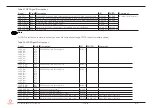
Copyright
©
2022
congatec
GmbH
TSTLm01
44/72
Wake Event
Conditions/Remarks
USB Mouse/Keyboard Event
When standby mode is set to S3, USB hardware must be powered by standby power source.
Set USB Device Wakeup from S3/S4 to “Enabled” in the ACPI setup menu (if setup node is available in BIOS setup program).
In device manager, look for the keyboard/mouse devices. Go to the Power Management tab and check ‘Allow this device to bring the
computer out of standby’.
RTC Alarm
Activate and configure Resume On RTC Alarm in the power setup menu. Only available in S5.
Watchdog Power Button Event Wakes unconditionally from S3-S5
7.6
SoDIMM Population Rules
The Intel TigerLake SoC featured on the conga-TS570 supports ECC and non-ECC DDR4 memory modules, up to 3200 MT/s. The DDR4
memory modules have lower voltage requirements with higher data rate transfer speeds. They operate at a nominal voltage of 1.2 V. With this
low voltage system memory interface, the conga-TS570 offers a system optimized for lowest possible power consumption. The reduction in
power consumption due to lower voltage subsequently reduces the heat generated.
The diagram below shows the location of the memory slots on the conga-TS570.
The following population rules must be observed:
•
For single memory module, either of the top slots can be populated (ch0:D0 or ch1:D0).
•
The top, upper slot (ch0:D0) must be populated if the bottom slot (ch0:D1) is populated.
– The module will not boot (POST code 53) if only the bottom slot is populated in a single memory configuration.
– The module will not boot (POST code 53) if the bottom slot and the top, lower slot are populated in a double memory configuration.
– POST code “53” indicates that no memory module is detected.
•
Use same DIMMs (same part numbers) in channel 0 (top, upper slot and bottom slot). Mixing DIMMs in this channel will reduce the speed
to 2933 Mhz.
Top, upper slot (Ch0:D0)
Ch = Channel
D = DIMM
Top, Lower slot (Ch1:D0)
Bottom slot (Ch0:D1)
Intel TigerLake-H Processor
COM Express MXM Connector




































